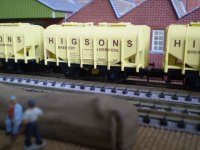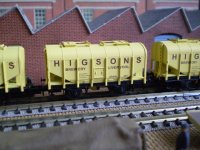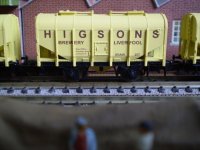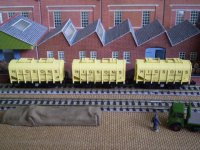Three of our Higsons bulk grain hopper wagons.
The process of brewing beer consists fundamentally of steeping a starch source in water, then fermenting with
yeast to turn the starch into alcohol. People were doing this eight thousand years ago, and the basic principles
remain exactly the same today. The starch source is normally cereal grains, and the grain of choice for most
modern brewers is barley due to the helpful enzymes in its fibrous husk. A decent-sized brewery will be getting
through tons of the stuff every working day, so they'll be needing fresh stocks delivered regularly and in quantity.
When Higsons were brewing up a batch of their best bitter for the pubs & clubs of Merseyside then they'd
be needing plenty of fresh barley at their Stanhope Street brewery, and one 20-ton wagonload wouldn't have kept
things going for very long. Bulk deliveries of several wagons at a time would have been a regular event to keep
the mash tuns simmering, and help keep the railway freight-handling charges down as well. The company
accountants would raise a glass to that.
Roll out the barrel on your layout with our Higsons rake.
Please note that these wagons are boxed individually.
|









